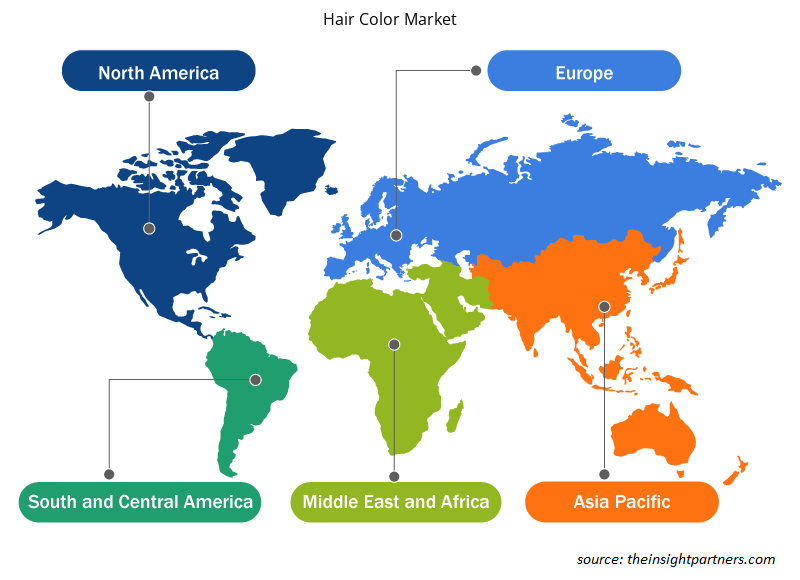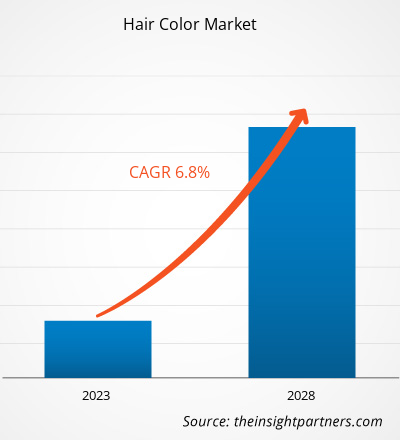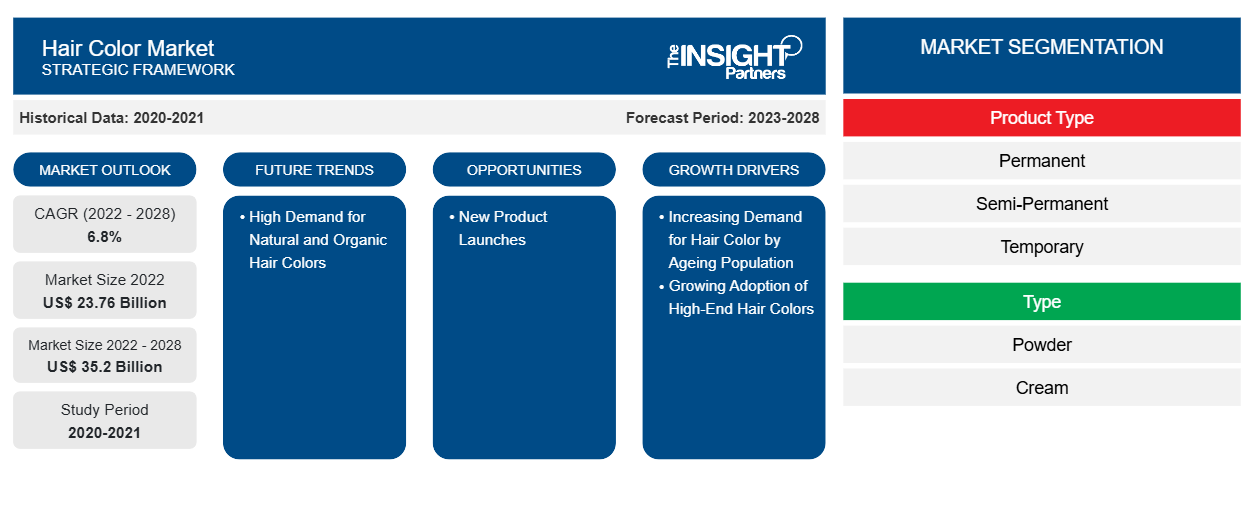[Informe de investigación] Se espera que el mercado de coloración del cabello crezca de US$ 23.762,28 millones en 2022 a US$ 35.201,69 millones en 2028; se estima que crecerá a una CAGR del 6,8% entre 2022 y 2028.
El informe destaca los factores clave que impulsan el mercado y los actores destacados junto con sus desarrollos en el mercado.
Perspectivas del mercado y opinión de analistas:
Los tintes para el cabello son tintes que se aplican para cubrir las canas o para cambiar el color natural del cabello. Básicamente, existen 3 tipos de tintes para el cabello: permanentes, semipermanentes y temporales. Los tintes para el cabello permanentes cambian permanentemente el color natural del cabello y generalmente brindan los mejores resultados. Los tintes para el cabello están disponibles en varios tonos de color, como negro, marrón y burdeos. Los consumidores están muy preocupados por su apariencia, lo que está creando una demanda significativa de productos de cuidado personal. Este factor está impulsando el mercado de tintes para el cabello . Además, el creciente envejecimiento de la población también es uno de los principales factores que impulsan la demanda de tintes y colorantes para el cabello.
Factores impulsores del crecimiento y desafíos:
La creciente demanda de tintes para el cabello por parte de la población que envejece está impulsando el crecimiento del mercado de tintes para el cabello. Según el Informe sobre el envejecimiento de la población mundial de 2019, hay más de 703 millones de personas de 65 años o más en el mundo. La población mundial está envejeciendo rápidamente debido a la disminución de las tasas de fertilidad y al aumento de la longevidad o la esperanza de vida. La población que envejece utiliza ampliamente el tinte para el cabello para cubrir sus canas . Este factor está impulsando significativamente la demanda de tintes para el cabello. Además, debido a los cambios en el estilo de vida y las deficiencias nutricionales, existe una tasa creciente de encanecimiento prematuro . Las personas están siendo testigos del encanecimiento prematuro del cabello debido al estrés diario, los malos hábitos alimenticios, el tabaquismo y ciertas afecciones médicas. También se espera que este factor impulse la demanda de tintes para el cabello, impulsando el crecimiento del mercado de tintes para el cabello.
Personalice este informe según sus necesidades
Obtendrá personalización en cualquier informe, sin cargo, incluidas partes de este informe o análisis a nivel de país, paquete de datos de Excel, así como también grandes ofertas y descuentos para empresas emergentes y universidades.
-
Obtenga las principales tendencias clave del mercado de este informe.Esta muestra GRATUITA incluirá análisis de datos, desde tendencias del mercado hasta estimaciones y pronósticos.
Segmentación y alcance del informe:
El “mercado global de coloración del cabello” está segmentado según el tipo de producto, tipo, canal de distribución y geografía.Según el tipo de producto, el mercado de coloración del cabello se segmenta en permanente, semipermanente y temporal.Según el tipo, el mercado de coloración del cabello se segmenta en polvo, crema y otros. Según los canales de distribución, el mercado de coloración del cabello se segmenta en supermercados e hipermercados, tiendas especializadas, venta minorista en línea y otros. El mercado de coloración del cabello según la geografía se segmenta en América del Norte (EE. UU., Canadá y México), Europa (Alemania, Francia, Italia, Reino Unido, Rusia y resto de Europa), Asia Pacífico (Australia, China, Japón, India, Corea del Sur y resto de Asia Pacífico), Oriente Medio y África (Sudáfrica, Arabia Saudita, Emiratos Árabes Unidos y resto de Oriente Medio y África) y América del Sur y Central (Brasil, Argentina y resto de América del Sur y Central).
Análisis segmental :
Según los canales de distribución, el mercado de coloración del cabello se segmenta en supermercados e hipermercados, tiendas especializadas, venta minorista en línea y otros. El segmento de supermercados e hipermercados tiene una participación significativa del mercado de coloración del cabello y se espera que el segmento de venta minorista en línea registre un crecimiento significativo durante el período de pronóstico. Los supermercados e hipermercados son grandes establecimientos minoristas que almacenan una variedad de productos de marcas locales y premium a precios asequibles. Además, estas tiendas cuentan con personal calificado que ayuda a encontrar productos de acuerdo con los requisitos del cliente. Además, estas tiendas tienen secciones separadas de cosméticos y productos de cuidado personal que ayudan a los clientes a comprar de manera conveniente y sin complicaciones. Estos factores están impulsando las ventas de productos para teñir el cabello a través de supermercados e hipermercados.
Según el tipo, el mercado de coloración del cabello se segmenta en polvo, crema y otros. En 2022, el segmento de polvos tuvo la mayor participación de mercado. Una gran cantidad de consumidores prefieren el colorante para el cabello en crema debido a su facilidad de aplicación. Además, contienen ingredientes humectantes que suavizan el cabello y le dan brillo. Estos factores están impulsando significativamente el crecimiento del segmento.
Análisis regional:
Según la geografía, el mercado de coloración del cabello se divide en cinco regiones clave: América del Norte, Europa, Asia Pacífico, América del Sur y Central, y Oriente Medio y África. El mercado mundial de coloración del cabello estuvo dominado por Asia Pacífico, que representó US$ 7.741,75 millones en 2022. América del Norte es el segundo contribuyente principal con más del 26% de participación en el mercado mundial. La industria cosmética en Asia Pacífico está creciendo, con una creciente demanda de productos premium y un aumento en el número de mujeres trabajadoras. Además, el envejecimiento de la población en la región está contribuyendo aún más al crecimiento del mercado de coloración del cabello. Según la Organización Mundial de la Salud (OMS), China tiene una de las poblaciones envejecidas de más rápido crecimiento en el mundo. Se proyecta que la población de personas mayores de 60 años en China alcance el 28% para 2040, debido a la mayor esperanza de vida y la disminución de las tasas de fertilidad. Por lo tanto, se espera que la creciente demanda de cuidado personal junto con el creciente número de mujeres trabajadoras y el envejecimiento de la población impulsen el crecimiento del mercado de coloración del cabello en Asia Pacífico.
Desarrollos industriales y oportunidades futuras:
A continuación se enumeran varias iniciativas adoptadas por los actores clave que operan en el mercado del color del cabello:
- En 2022, The Arctic Fox lanzó un nuevo color de cabello, Space Cowgirl, que son colores brillantes con tonos verdes o tonos melocotón. Este nuevo producto se puede mezclar con Aquamarine, Poseidon, Neon Moon, Frose o Periwinkle, en distintas proporciones según lo proporcionado por la empresa, para obtener diferentes tonos de color para el cabello.
- En 2022, PZ Cussons anunció la adquisición de Childs Farm, la marca líder en el mercado de productos de cuidado personal para bebés y niños del Reino Unido, con una participación del 15 % en la categoría. Las líneas de productos incluyen productos para el baño y la ducha, cuidado de la piel y cuidado del cabello, y todos se basan en una propuesta natural y son aptos para pieles sensibles.
- En 2022, L'Oréal SA anunció el lanzamiento de Colorsonic, diseñado para consumidores, y de las tecnologías Coloright, diseñadas para estilistas. La empresa trabajó con 400 clientes para desarrollar los productos Colorsonic. El producto contiene un cartucho de color (40 colores), un mezclador (combina el color y lo desarrolla para el cliente) y un aplicador tipo peine. Además, la tecnología Coloright se centra en crear consistencia y agregar información de datos en el proceso de coloración.
Perspectivas regionales del mercado de coloración del cabello
Los analistas de Insight Partners explicaron en detalle las tendencias y los factores regionales que influyen en el mercado de coloración del cabello durante el período de pronóstico. Esta sección también analiza los segmentos y la geografía del mercado de coloración del cabello en América del Norte, Europa, Asia Pacífico, Oriente Medio y África, y América del Sur y Central.

- Obtenga datos regionales específicos para el mercado de coloración del cabello
Alcance del informe sobre el mercado de coloración del cabello
| Atributo del informe | Detalles |
|---|---|
| Tamaño del mercado en 2022 | US$ 23,76 mil millones |
| Tamaño del mercado en 2028 | US$ 35,2 mil millones |
| CAGR global (2022-2028) | 6,8% |
| Datos históricos | 2020-2021 |
| Período de pronóstico | 2023-2028 |
| Segmentos cubiertos |
Por tipo de producto
|
| Regiones y países cubiertos |
América del norte
|
| Líderes del mercado y perfiles de empresas clave |
|
Densidad de actores del mercado de coloración del cabello: comprensión de su impacto en la dinámica empresarial
El mercado de tintes para el cabello está creciendo rápidamente, impulsado por la creciente demanda de los usuarios finales debido a factores como la evolución de las preferencias de los consumidores, los avances tecnológicos y una mayor conciencia de los beneficios del producto. A medida que aumenta la demanda, las empresas amplían sus ofertas, innovan para satisfacer las necesidades de los consumidores y aprovechan las tendencias emergentes, lo que impulsa aún más el crecimiento del mercado.
La densidad de actores del mercado se refiere a la distribución de las empresas o firmas que operan dentro de un mercado o industria en particular. Indica cuántos competidores (actores del mercado) están presentes en un espacio de mercado determinado en relación con su tamaño o valor total de mercado.
Las principales empresas que operan en el mercado de coloración del cabello son:
- Zorro ártico
- Compañía Inc.
- Henkel AG & Co. KGaA
- Compañía: Kao Singapore Pte Ltd.
- yo
Descargo de responsabilidad : Las empresas enumeradas anteriormente no están clasificadas en ningún orden particular.

- Obtenga una descripción general de los principales actores clave del mercado del color del cabello
Impacto del Covid-19:
La pandemia de COVID-19 afectó a casi todas las industrias en varios países. Los confinamientos, las restricciones de viaje y los cierres de empresas en América del Norte, Europa, Asia Pacífico (APAC), América del Sur y Central (SAM) y Oriente Medio y África (MEA) obstaculizaron el crecimiento de varias industrias, incluida la industria de bienes de consumo. El cierre de las unidades de fabricación perturbó las cadenas de suministro globales, las actividades de fabricación, los cronogramas de entrega y las ventas de productos esenciales y no esenciales. Varias empresas experimentaron retrasos en las entregas de productos y una caída en las ventas de sus productos en 2020. Debido a la recesión económica inducida por la pandemia, los consumidores se volvieron más cautelosos y selectivos en sus decisiones de compra. Sin embargo, la pandemia provocó cierres temporales de salones de belleza, lo que obligó a muchos consumidores a teñirse el cabello en casa. Esto aumentó la demanda de tintes para el cabello en todo el sector residencial. Además, como se ordenó a las personas que se quedaran en casa, participaron en diversas actividades de bricolaje que impactaron positivamente en las ventas de tintes para el cabello. Sin embargo, como los supermercados, hipermercados, centros comerciales y tiendas que venden productos no esenciales permanecieron cerrados durante la fase inicial de la pandemia, la gente dependió de los canales minoristas de comercio electrónico como Amazon.com, eBay y SnapDeal.
A finales de 2021, muchos países ya estaban completamente vacunados y los gobiernos anunciaron la relajación de ciertas normativas, como los confinamientos y las prohibiciones de viaje. Se permitió la reapertura de varias tiendas, como supermercados, tiendas departamentales, centros comerciales y tiendas familiares, lo que también aumentó la venta de productos para teñir el cabello. Todos estos factores influyeron positivamente en el crecimiento del mercado de la coloración del cabello.
Panorama competitivo y empresas clave:
Algunos de los actores destacados que operan en el mercado mundial de coloración del cabello incluyen:Arctic Fox; Coty Inc.; Henkel AG and Co., KGAA; y Kao Singapore Pte. Ltd.; Revlon, Inc.; Hygienic Research Institute Pvt. Ltd; L'oréal SA; Wella Operations US LLC; Unilever PLC; y PZ Cussons Beauty LLP; entre otras. Estas empresas están muy involucradas en actividades de fusión y adquisición para expandir su presencia geográfica y mejorar su experiencia. Además, estas empresas están adoptando estrategias de marketing innovadoras, como marketing digital, marketing en redes sociales y campañas publicitarias innovadoras para mejorar su imagen de marca en la mente de los consumidores potenciales.
- Análisis histórico (2 años), año base, pronóstico (7 años) con CAGR
- Análisis PEST y FODA
- Tamaño del mercado, valor/volumen: global, regional y nacional
- Industria y panorama competitivo
- Conjunto de datos de Excel
Informes recientes
Informes relacionados
Testimonios
Razón para comprar
- Toma de decisiones informada
- Comprensión de la dinámica del mercado
- Análisis competitivo
- Información sobre clientes
- Pronósticos del mercado
- Mitigación de riesgos
- Planificación estratégica
- Justificación de la inversión
- Identificación de mercados emergentes
- Mejora de las estrategias de marketing
- Impulso de la eficiencia operativa
- Alineación con las tendencias regulatorias























 Obtenga una muestra gratuita para - Mercado de coloración del cabello
Obtenga una muestra gratuita para - Mercado de coloración del cabello